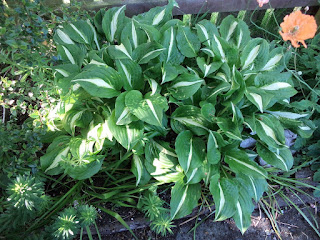There's nothing special about this plant: it is a Rowan or Mountain Ash (Sorbus aucuparia), a common enough tree in this part of the world.
Except it is a special tree for this is the first time it has flowered in the time I have been in this back garden. I didn't plant it and someone had hacked it back in the past but each year it has done its stuff with its leaves until now when it has bloomed. Just the one corymb (as the cluster of tiny flowers is called) but beautiful to my mind's eye.
And what is more, according to Scottish tradition, because it is at the entrance to my back garden then no evil will flourish there.
Evil may not flourish but black aphids can: they are coating this Red Campion (Silene dioica), which is also a first for this garden (the coating not the campion).
If you look closely you will also see the sticky white mess that is beginning to coat the leaves below them too. It seems to be the only plant affected. Why? Well unlike the other Red Campions this plant is in a pot and we have had a very dry period. It is also in a more shaded spot. This could mean the plant is under greater stress than the others and if I am to believe what I read then stressed plants seem to be more susceptible to pests.
My plan is to water it and see if the aphids disappear - sometimes they do if you just leave them. We shall see.
Some of the other Campion in a happier spot in the ground and although this is not a close up please believe me when I say this is not affected - yet.
And from another angle.
Following the grass path through my meadow-in-long-term-progress can take you to at least two places. The choice is yours or mine.
This is one of my edible spots with potatoes in bags and dwarf runner beans in containers - the beans are flowering now,
Maybe the beans will give me some beans and maybe the potatoes will give me some potatoes.
Who knows? Not me. All I know is that in a few weeks time they will look very different from how they do now.
The other possible destination from the grass path is the bluebell patch (Hyacinthoides non-scripta maybe). I can pretend I am in an English woodland if I wish or even Scottish lowland one).
At least I can today.
The edge of that woodland moves to the Himalayas where the recently planted Giant Lillies (Cardiocrinum giganteum) seem to be enjoying their new mulch that I hope will keep the moisture in and the slugs out (with a little help from the copper bands around the cut-off pot rims.
The Sycamore (Acer pseudoplatinus) is now in full canopy and where once there was sun there is now afternoon and evening shade.
For the moment the Plantain Lilies are enjoying that shade - before the slugs get to the,
Today this is my favourite: Hosta 'Sharmon.'
The large slightly glaucous leaves of Hosta sieboldiana.
And the spreading Hosta 'Risky Business.'
And just in case you were wondering about the poppy in the preceding picture here is a closer look at one of the blooms. I believe this to be the Spanish Poppy Papaver rupifragum but I could be wrong.
I would be very happy if someone could confirm or disprove my identification.
And while this may be dry shade the ornamental onions still seem happy (Allium hollandicum 'Purple Sensation'). The blooms would probably be larger in full sun but they are happy here and are complemented by the little specks of flowers of wild flower Herb Robert (Geranium robertianum) - not my plan. Sometimes things happen.
But whatever happens, I hope my garden will continue to be a haven for wildlife. Whoever thought an owl, tree frog and badger could live so harmoniously together one the one Yew (Taxus baccata) tree stump?
Things seem strange? They will change. But how they may change is is way beyond me. If you know the answer be sure and let me know.









































